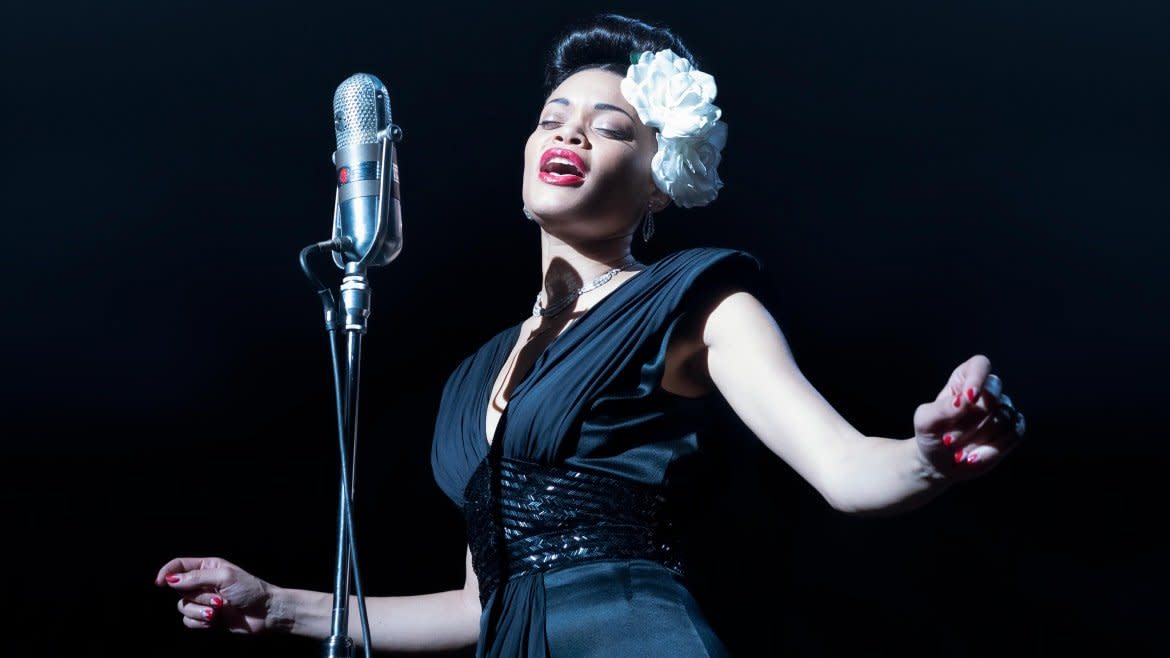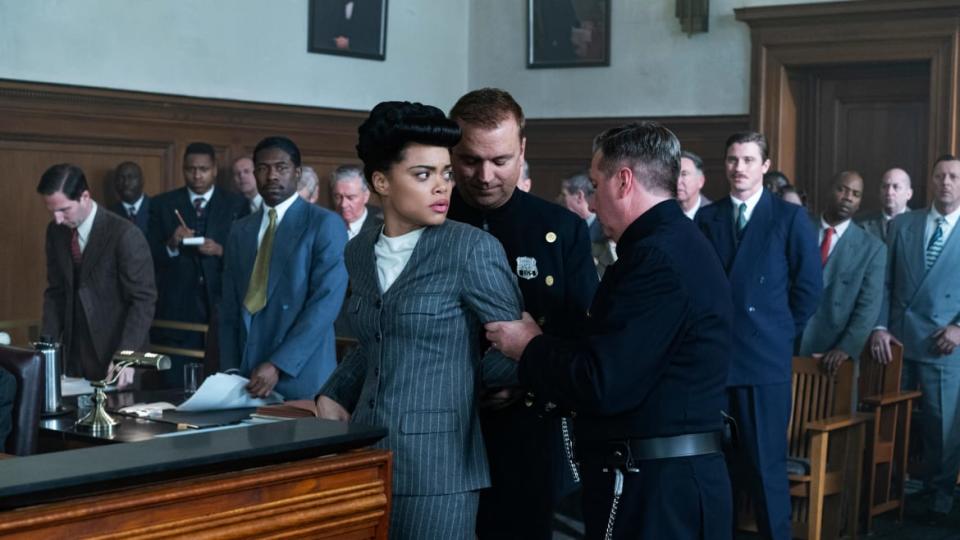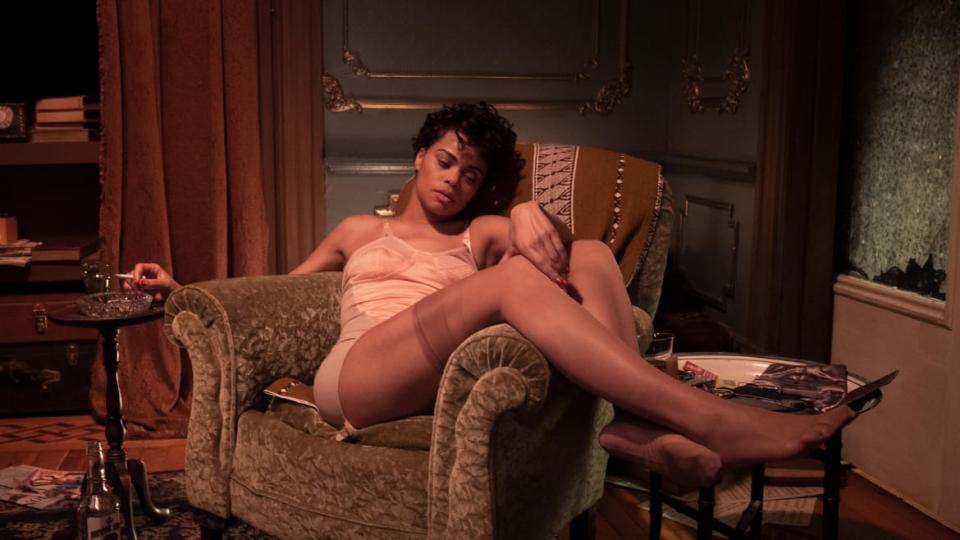Andra Day Abused Herself to Become Billie Holiday. Why She Felt It Was Worth It.

- Oops!Something went wrong.Please try again later.
- Oops!Something went wrong.Please try again later.
Everyone kept telling Andra Day she looked different, but she couldn’t see it.
It had been happening for the better part of the last three years, ever since director Lee Daniels tapped the Grammy-nominated singer, best known for her anthem of uplift, “Rise Up,” to play legendary blues icon Billie Holiday in the new film The United States vs. Billie Holiday (out Friday on Hulu).
It started soon after Day’s first meeting with Daniels. At first, the mere suggestion of taking on one of her biggest idols—and one of the most tumultuous, tragic life stories in show business—for her first acting role felt daunting and seemingly preposterous. She recoiled and said, “Hell no.” But after an ace audition, she agreed and immersed herself not only in an emotional and mental education on Holiday’s life, lapping up every video, recording, book, and interview she could get her hands on, but a physical one, too. She abused her body.
She took up drinking for the first time—a lot of gin and bourbon—and started smoking cigarettes. She was picking up the bad habits that, as a professional singer, she was warned to steer away from to protect her voice, even resorting to screaming some conversations to exhaust her vocal cords. She didn’t just want to feel more like Holiday, who had addiction issues and was notoriously volatile. She needed help developing the singer’s signature rasp.
There was drastic weight loss leading up to the shoot. Day shed almost 40 pounds, dropping from 163 down to 124. Then came the hair, makeup, and wardrobe transformation. She cut off her hair, which at that point hung down to her hip, and the film’s hairstylist painted her updos with shoe polish for an even blacker sheen. But the pièce de résistance were the color contacts that made Day’s sparkling, hazel-green eyes a deep, soulful brown.
The fawning over her transformation when she walked on set confused her. For a long time when friends and family began to watch her performance in the film, for which she is nominated for a Golden Globe Award at Sunday’s ceremony, it still did. “I was like, really? I just have on my brown contacts and a wig!” she says in a recent interview with The Daily Beast.
But then a friend showed her a meme of the actress Zooey Deschanel, famous for her piercing blue eyes, rendered unrecognizable with her eyes PhotoShopped brown, and she understood—to an extent. She could recognize that, yes, to perform as Billie Holiday she has made herself look different on the outside. But after doing all that work, the two performers had become one.

“When I saw myself on set for the first time, I believed that I had been living as her for a bit of time,” she says. “It just felt like looking at myself in the mirror, except myself at that time was Billie Holiday.”
It’s happened when she’s walking through a store and a Holiday song plays on the loudspeaker, or when one of the countless songs she has on her phone or computer comes on a playlist; after all, she’s been performing the jazz singer’s songs, sometimes to anyone who would listen, since she was 11.
It’s happened lately while doing press for The United States vs. Billie Holiday, when a picture of the icon is shown in a clip or on a set. Just the other night, a random piece of conversation with one of her friends triggered it: the Billie Holiday that’s still inside her.
“It's a long time to be so deeply in another person, and I’m still pretty not clear about who I am,” Day says.
These three years of her life have been paradigm-shifting, and they’ve been difficult. “It's better now. I’m not on a cliff the way I was when we finished filming. But, you know, I don't know who I am fully outside of her. Sometimes it can be kind of scary trying to figure that out.”
She brings up that word “triggered” again to describe it. If you look at how Diana Ross and Audra MacDonald, two of the most talented and celebrated performers of our time, summoned new depths of skill and feeling in their respective channelings of Holiday in Lady Sings the Blues and Lady Day at Emerson’s Bar and Grill, respectively, you’ve borne witness to it, Day says. “She grips you,” then with a laugh: “You know, Lady is one of those forces that... she’s got unfinished business.”
The United States vs. Billie Holiday centers on a specific aspect of Holiday’s life that, for all the legend surrounding her—after cementing a legacy as one of jazz’s greatest voices, she died in 1959 at age 44 after a tortured battle with drugs and alcohol—is largely unknown.
Daniels and Pulitzer Prize-winner Suzan-Lori Parks adapted the film from a section of Johann Hari’s 2015 book on drug criminalization, Chasing the Scream. As part of the U.S. federal government’s effort to racialize the war on drugs, agents targeted Holiday, whose narcotics use was somewhat of an open secret.
Holiday’s stirring performance of protest anthem “Strange Fruit,” based on a poem about lynching by Abel Meeropol, had become one her most requested songs at concerts. By 1947, the Federal Bureau of Narcotics had warned her management that Holiday wasn’t to sing the song, for fear that her Black fans living under Jim Crow would be riled by its vivid, haunting imagery and message of injustice.
Frustrated that he could only nab her on a riot charge when she performed it—not enough to keep her from singing—then-chief of the Bureau Harry Anslinger (played by Garret Hedlund) instead goes after her heroin habit, staging stings and sometimes framing her in order to put her behind bars.
The film takes place during the last 12 years of Holiday’s life, when she’s not just fighting for survival against her own demons, but against those working to silence her. For too long, this part of her legacy had been silenced, too.
“These stories were not told,” Day says. “They were intended to never be told. That's the thing that this generation needs to understand. You're hearing the Billie Holiday story now because you never heard about the Billie Holiday story. How many more Black and brown marginalized LGBTQ+ stories have been suppressed and have been altered to limit the scope of their struggle and contribution and triumph? That's intentional. America—and not just people of color—America does not know their history because America actively tried to change that history.”
***
Reliving that time of Holiday’s life also meant portraying her declining health throughout the ’50s as she tried desperately but struggled to control a heroin habit and a dependence on alcohol. In a way, Day’s headline-making weight loss for the role helped with that, too.
Day’s trick for dropping 40 pounds wasn’t revolutionary: She drastically shrank her caloric intake. There was exercise involved, too, but she didn’t want a tight, 2021-signaling gym body. She wanted to look appropriate for the period, with loose skin where Day would have had it and with jarring gauntness and hollowness in the face—a result of not only her weight loss, but also the fact that the abuse on her body was causing her to stop sleeping.
Essentially starving herself meant that she was more lethargic, a break from her own normally hyper movements that allowed her to melt into Holiday’s slower rhythm, not to mention better play the scenes in which she was high on heroin.
It’s a film role that would put any performer through the wringer, let alone a singer who was acting for the first time in a major movie. She had to play high, play drunk, play a person on her deathbed, and act out upsetting scenes in which she’s physically abused by lovers.
There are graphic sex scenes and nudity, which were certainly interesting for Day. Years ago, she had made a commitment to abstinence. “It's funny to go from not doing it at all to just like, ‘Hey everybody! I was thinking I’d get naked and just pretend to have sex on camera in front of a bunch of strangers!’” she laughs.

Then there’s the voice—Billie Holiday’s voice, no less—and the pressure of doing justice to the legacy of such an important, well-known person.
“It’s her gangsta, too,” Day says. “It was a different era. Like growing up, I’d seen some shit as a young person, but Billie Holiday is a gangsta-gangsta. Like this is something different. How do I pull off being that hard but also being that vulnerable? Being approachable but also being, like, she'd probably whoop somebody's ass in a second? How do you balance those two worlds?”
And then she had to sing “Strange Fruit.”
It’s probably the most important sequence in the movie, one that Day performs so movingly that it’s hard to shake long after you’ve watched it. It’s a song that Day had performed before in her singing career, but it had to be different this time. She was Holiday, and she had to shoulder the weight of all those years putting her life at risk and all the paranoia and defiance her dealings with the feds had instilled—all because she believed the message of “Strange Fruit” was one that needed to be performed and shared.
“Before when I sang it, it was a performance and it was an homage to Billie Holiday and to ‘Strange Fruit,’” Day says. “But singing it on set, it was urgent. I needed for people to stop listening to the song and go, ‘Wow, that’s so beautiful.’ It’s not a beautiful song. The song is ugly and it’s painful. And it puts a spotlight and a target on the back of whoever is singing it.”
She needed to find a way for anyone who was on set or watching the film to forget they’re watching a performance. To become entranced by the lyrics. To really hear them, “and to do something about the message about lynching,” Day says.
“For me now, understanding that lynching is still happening—it's just happening systemically, which is a successful creation of people like Harry Anslinger and J. Edgar Hoover—it’s an urgent need for people to hear it. Not to enjoy it, but to really hear it and process it and let it move them.”
Get our top stories in your inbox every day. Sign up now!
Daily Beast Membership: Beast Inside goes deeper on the stories that matter to you. Learn more.

